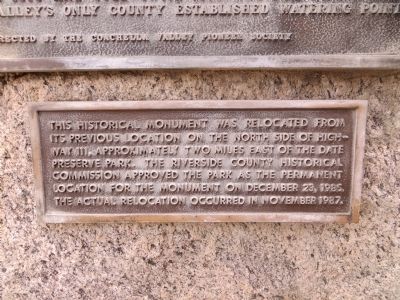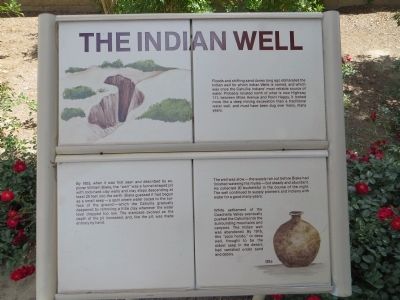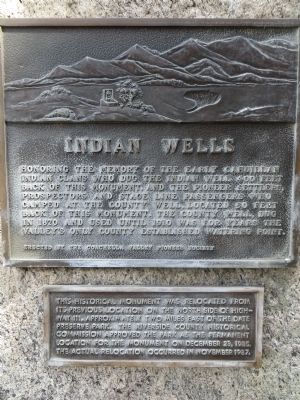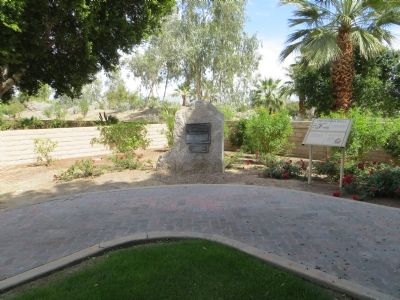Indian Wells in Riverside County, California — The American West (Pacific Coastal)
Indian Wells
Erected by the Coachella Valley Pioneer Society.
Topics. This historical marker is listed in this topic list: Native Americans. A significant historical year for this entry is 1870.
Location. 33° 43.317′ N, 116° 20.271′ W. Marker is in Indian Wells, California, in Riverside County. Marker is on California Route 111, 0.1 miles east of El Dorado Drive, on the right when traveling west. Touch for map. Marker is in this post office area: Indian Wells CA 92210, United States of America. Touch for directions.
Other nearby markers. At least 8 other markers are within 7 miles of this marker, measured as the crow flies. Eisenhower Mountain (a few steps from this marker); Dwight David Eisenhower (within shouting distance of this marker); Eisenhower Walk of Honor (within shouting distance of this marker); Carl G. Bray, Smoke Tree Painter (approx. 1.6 miles away); The Bradshaw Trail / Point Happy (approx. 2˝ miles away); Palm Desert Historical Society Vietnam War Memorial (approx. 3.2 miles away); Palm Springs Land and Irrigation Company (approx. 3.7 miles away); Jimmy Swaggart's "Date" (approx. 6.2 miles away). Touch for a list and map of all markers in Indian Wells.

Photographed By Bill Kirchner, March 29, 2015
3. Small plaque below Indian Wells Marker
This historical monument was relocated from its previous location on the north side of highway 111, approximately two miles east of the Date Preserve Park. The Riverside County Historical Commission approved the park as permanent location for the monument on December 23, 1985. The actual relocation occurred in November 1987.

Photographed By Bill Kirchner, March 29, 2015
5. Sign near marker about the history of Indian Wells
Floods and shifting sand dunes long ago obliterated the Indian well for which Indian Wells in named, and which was once the Cahuilla Indians' most reliable source of water. Probably located north of what is now Highway 111, between Miles Avenue and Point Happy, it looked more like a deep mining excavation than a traditional water well, and must have been dug over many, many years.
By 1853, when it was first seen and described by explorer William Blake, the "well" was a funnel-shaped pit with rock-hard clay walls and clay steps descending at least 25 feet into the earth. Blake guessed it had begun as a small seep--a spot where water oozed to the surface of the ground--which the Cahuilla gradually deepened by removing a little clay whenever the water level dropped too low. The staircase evolved as the depth of the pit increased, and, like the pit, was made entirely by hand.
The well was slow--the supply ran out before Blake had finished watering his mules--but steady and abundant. He collected 20 bucketsful in the course of the night. The well continued to supply pioneers and Indians with water for a good many years.
White settlement of the Coachella Valley eventually pushed the Cahuilla into the surrounding mountains and canyons. The Indian well was abandoned. By 1916, this "pozo hondo," or deep well, thought to be the oldest seep in the desert, had vanished under sand and debris.
Credits. This page was last revised on June 16, 2016. It was originally submitted on April 4, 2015, by Bill Kirchner of Tucson, Arizona. This page has been viewed 1,021 times since then and 158 times this year. Last updated on April 17, 2015, by J. Makali Bruton of Accra, Ghana. Photos: 1, 2, 3, 4, 5. submitted on April 4, 2015, by Bill Kirchner of Tucson, Arizona. • Syd Whittle was the editor who published this page.


